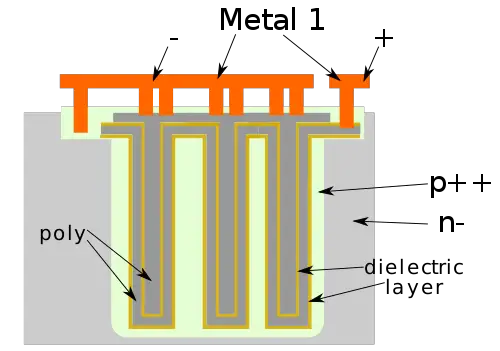From WikiChip
Deep Trench Capacitor (DTC)
A deep trench capacitor (DTC) is a three-dimentional vertical capacitor formed by etching a deep trench (DT) into a silicon substrate.
Overview[edit]
- Deep trench capacitors (DTCs) are vertical semiconductor devices that are used to add capacitance to various integrated circuits.
- An advantage of using DTCs over package decaps is that they can be freely placed as close as possible to the desired circuit.
- Additionally, DTCs provide higher capacitance per unit area over other solutions such as a MIM cap.
Uses[edit]
- Memory
- DTCs form the main storage capacitor for one of the main families of eDRAM-based cells called 'Embedded DRAM' which
- is fabricated on a standard CMOS process, allowing the mixture of memory and logic on the same integrated circuit
- (as opposed to generic eDRAM ICs which relies on a special process not suitable for general logic).
- Logic
- DTCs are unique in many ways from other capacitors. First, they are formed by etching deep trenches (DTs) into the substrate.
- This enables very high capacitance density, especially when they are coupled in parallel.
- Secondly, because they tend to be very thin and deep, when combined with the logic above, they may be used to form
- very dense structures such as embedded DRAM, PLL loop filters, decoupling circuitry, and other power applications.
- Industry
- DTCs are used by a number of semiconductor companies in volume production:
- IBM uses DTCs for their eDRAM technology which are used to build very fast and very large L2, L3, and L4 caches.
- TSMC added DTCs called iCAPs to its CoWoS packaging technology, significantly increasing the capacitance density
- allowing construction of higher quality power delivery networks (PDN).
This list is incomplete; you can help by expanding it.
See also[edit]
- stacked capacitor (SC)
- capacitor over bit (CoB)
- embedded DRAM (eDRAM)
- deep trench (DT)

